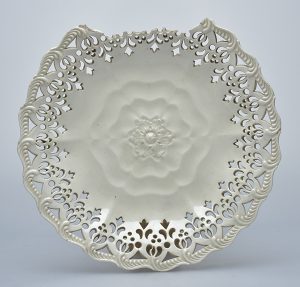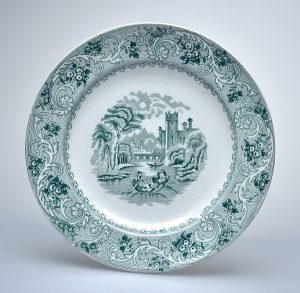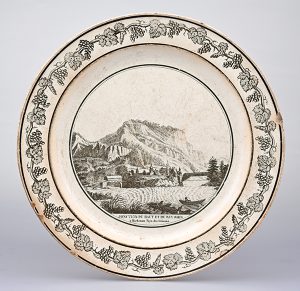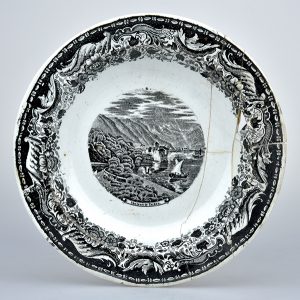



Creamware (white-bodied industrial earthenware, refined white earthenware, industrial whitewares) evolved in the 1740s from the salt-glazed white stoneware of Staffordshire and Yorkshire (England). At the time it was known as “cream-coloured ware” or “Queen’s ware”. From the late 18th century, white-bodied industrial earthenwares or refined white earthenwares were also produced in France, Germany and Switzerland under various names (“terre des pipes”, “cailloutage”, “faïence fine anglaise”). For marketing purposes and because of changes in the clay compositions, the pottery industry in the 19th century introduced several other names, including “demi-porcelaine”, “porcelaine opaque”, “mi-porcelaine”, “kaolina” and “pétrocérame”.
Due to the colour and matrix of its fabric, creamware is now also known as “weisse Irdenware” – “white earthenware, white-bodied industrial earthenware, refined white earthenware” – “terres blanches” – “terraglia”. Because it was manufactured in dedicated industrial plants, refined white eartenware in all its forms is also known as “industrial pottery or industrial fineware”, which puts an intentional emphasis on the fact that it was not manually produced by craftspeople.
As a rule, the fabric is light-coloured to light-grey, slightly cream-coloured to yellowish or almost white, very fine-grained, non-vitreous, specifically light-weight and with a clearly visible separate layer of glaze. The latter often exhibits craquelure, or crazing. From a technical perspective, creamware is lead-glazed, porous earthenware made from clay that when fired becomes white and contains kaolin and SiO2 (quartz, often powdered flint); it can also contain lime or feldspar or a mixture of all components. Depending on the date and place of production, the composition of the clay body can vary greatly. Creamware objects were generally biscuit-fired first. The painted or printed decoration was applied to the bisque and the piece was then glazed. The second firing at a temperature of around 1000 ºC is known as “glost firing”. A possible third step involves onglaze decorations, either painted or transfer printed, which are fixed in a third firing at around 800 ºC called “muffle firing“.
By adding cobalt to the cream-coloured or yellowish clay body of “cream-coloured ware”, English potters developed a white variant known as “whiteware”. “Pearlware”, where cobalt was added to the glaze, was an intermediate step between the two.
Creamware manufacturers, mainly in England, also developed other fabrics (black, red, yellow, blue, violet and green), which are also known in the literature as “Feinsteinzeug, grès fin or industrial fine stonewares – industrial redwares, industrial blackwares, industrial coloured wares ” because in these wares the body was more densely fused. They can be refered to as unglazed (“dry-bodied”) stonewares as well.
Over the course of the 19th century, the pottery industry developed yet further types of refined white earthenwares, which were considerably whiter and more impact-resistant. The clay bodies used contained greater amounts of feldspar and kaolin. These new ceramics were known by different names, including “Porcelaine opaque” or “granite ware”. They were fired at temperatures between 1180ºC and 1300ºC, with glost firing at 1050ºC to 1080ºC.
Translation Sandy Haemmerle
Ger: Steingut
Fr.: Faïence fine
Definitions, terminology and alternative names of creamware
Massey 2007
Roger Massey, Understanding Creamware, in: Tom Walford/Roger Massey, Creamware and Pearlware Re-examined, Beckenham 2007, 15-30.
Maire 2008
Christian Maire, Histoire de la faïence fine francaise 1743-1843, Le Mans 2008, 11-36
Maggetti 2018
Marino Maggetti, Archaeometric Analyses of European 18th-20th Century White Earthenware – A Review, in: Minerals, 2018, Issue 8.
Translation Sandy Haemmerle

